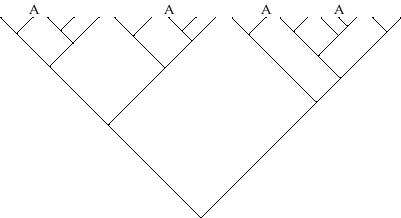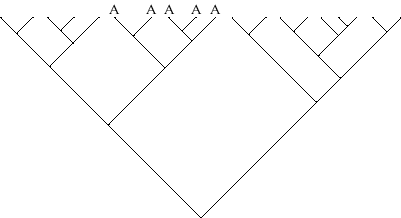
Evolution of sex (cont)
Species selection
Asexuality does in fact arise fairly often in different species, but completely
asexual populations nearly always go extinct relatively quickly.
This may be due to their inability to adapt quickly to environmental changes.
Evidence for this is the fact that (with one exception) we do not see
large and ancient clades of asexual organisms.
Rather, we see asexuality in a few recent branches on phylogenies, but these are
scattered across the phylogeny in such a way that they must have attained asexuality
independently and recently.
That is, when we plot asexuality (A) on a phylogeny it nearly always looks like this:

If asexual lineages persisted for very long, we would expect to see cases like this:

It thus appears that differential extinction of entire species or populations ("species selection") is one factor maintaining sexual reproduction.
The notable exception to this pattern is the clade comprising the Bdelloid
rotifers.
This is a large and ancient group that appears to have been completely
asexual for a long time.
How do we know that Bdelloids do not occasionally reproduce sexually, when humans are not looking?
---Genetic analysis shows that within each individual, the two copies of each gene have diverged so much at neutral sites that they appear to have been separated for over 40 million years.
---This will not happen in sexually reproducing populations, since drift will cause many neutral loci to be homozygous.
Sexuality is easily lost in rotifers, as it is in many groups that reproduce
both sexually and asexually.
What is notable about the Bdelloids is how long they appear to have lasted without it.
Quantitative Genetics
Also, see handout.
Continuous characters:
Characters are influenced by many loci, each with small effect.
Now, each genotype at a particular locus is associated with a distribution of phenotypes , rather than just one, because of variation at other loci.
Characters for which variation is influenced by many loci in this manner are called "Quantitative Characters" . The study of their evolution is Quantitative Genetics.
(Note that we are considering many genes of small effect; while we know that there are genes, such as various Hox genes, with large effect. The key is to keep in mind that we are only interested here in genes that contribute to variation in the character.)
So, how to summarize the effects of all of these genes?
Heritability (denoted by h2, for historical reasons)
Measures the degree to which offspring resemble their parents.
Defined as the slope of the regression of offspring phenotype on
parent phenotype . (See handout).
For organisms with sexual reproduction, we use the regression of
offspring phenotype on the mean phenotype of their parents ("midparent
phenotype").

It is almost always the case that: 0 < h2 < 1
Heritability determines whether or not selection can cause evolutionary change in a character.
Nearly all continuous characters, morphological or behavioral, have been shown to be heritable.
The Exception: Left-Right symmetry has
extremely low heritability in many organisms.
Interestingly, the tendency to be asymmetrical is heritable,
but the particular kind of asymmetry (e.g. left side bigger or
right side bigger) is not.
The fact that heritability is nearly always less than 1 means that the most extreme individuals in a population (e.g. the largest and the smallest, if the trait is body size) tend to have offspring that, on average, are closer to the mean phenotype than the parents are.
The reason for this is that the size (or value of any other trait) of an individual is influenced both by heritable ("genetic") factors and by non-heritable ("environmental") factors. The most extreme individuals are the ones for which both the genetic and environmental factors push them in the same direction. Their offspring, though, will inherit only the genetic factors.
Note that this requires only that some factors influencing the trait be heritable and others not. In fact, some things that are not part of our genome are heritable in that they are reliably passed on from one generation to the next. An example, in humans, of a heritable but not genetic factor is the particular language that one speaks.
Selection
Define:
S = Selection differential
= (mean of selected parents) - (mean of all individuals
in the parent generation)
R = Response to selection
= (mean of offspring) - (mean of all individuals
in the parent generation)
Then: R = h2 S

(Note that R < S for the normal case of h2 < 1. Hence the term "regression") Jul 8, 2021